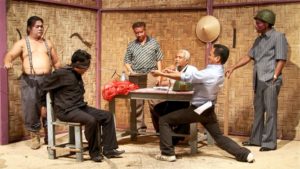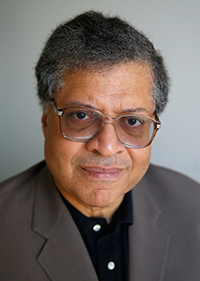The creepiest, most phantasmagorical movie I’ve seen this summer has no zombies, vampires, aliens or mutants. Unless, that is, you wished to apply any or all of the above to characterize Anwar Congo, the Indonesian gangster and wannabe moviemaker profiled in The Act of Killing, Joshua Oppenheimer’s true-life chronicle of how Congo tried to make a glorified cinematic re-enactment of his country’s mid-1960s massacre of thousands of men, women and children suspected of communism. This enterprisingly deadpan inquiry into the banality of evil has slithered its way into our season of sun-and-fun to announce that not only is fiction dead, but so is black (as in absurdist) comedy. Why even bother trying to outgun Nathaniel West when Real Life can hand off an acrid fungus of a storyline such as this?
It helps not only to have reality be so obliging, but to have the collective vanity of killers comply with Oppenheimer’s audacious request. Then again, what is viewed as atrocity almost everywhere else in the civilized world is still embraced as glory by many Indonesians, especially the far-right paramilitary group Permuda Panacasila whose members swarm around the edges of this saga like mean orange hornets. This cluster of baby martinets owes its existence, apparently, to Anwar Congo, who before the failed 1965 coup that led to the Suharto regime, dealt in black market movie tickets and other relatively petty thuggery. For two years, Congo led death squads throughout North Sumatra in a bloody purge of those suspected of being communists, including several hundred ethnic Chinese from whom he and his goons extorted money in lieu of death. Of the estimated half-million-to-a-million murdered throughout the country in 1965-66, Congo figures he personally killed roughly a thousand, mostly by garroting.
In the here-and-now of Oppenheimer’s film, Congo seems less a monster than a foxy grandpa, a leathery coot who clearly loves movies, especially the American musicals and action films that he claims to have been prohibited from showing in theaters by those reform-minded folk briefly in power between Sukarno and Suharto. To the adoring delight of Permuda Panacasila’s younger zealots, he constantly translates the word, “gangster”, as “free man,” which, one supposes, is Congo’s way of justifying wholesale slaughter as a type of cowboy heroism, a celebration of freedom without democracy. (The latter of which is viewed by a paramilitary leader, while whacking golf balls, as a nuisance getting in the way of progress. With such sentiments still holding sway in Indonesia’s government, you understand why most of the movie’s credits, including a co-director, are accompanied by the name, “Anonymous.”)
Congo, our (Scot-)Free Man of Indonesia, is not merely willing to put together staged re-enactments of his violent, terroristic acts; he’s jumping-up-and-down anxious for the chance to show posterity the valor and glory of his murdering, torturing brigands, complete with song-and-dance numbers. One of his larger, more menacing henchman even agrees to pose in drag-and-makeup as a gang-rape victim. He reminds you so much of the late great Divine that you think there has to be somebody in this outfit who’s got some sense of irony here. But they’re as serious about their entertainment in contemporary Indonesia as we are about our own reality TV indulgences. (Irony, I guess, is something you can better afford in more democratic realms.)
Other citizens seem just as happy to perform as victims, predators or rabble in this historic epic. He even gets one of his ex-associates to fly in to help, though this associate looks as if he’s already been weighed down through the years with self-recrimination – a warning, unheeded by Congo, of what’s in store. The only things that seem to bother Congo, on viewing rushes of his movie have more to do with verisimilitude e.g. fashion. (He says he wouldn’t have worn white pants while garroting a victim as shown in one scene. Always dark pants. He never says why…and why should he have to?)
But a pall seeps into the process as one actor, who boasts about turning in his girlfriend’s Chinese father to the death squads back in the day, is helping re-enact a brutal interrogation. At first, he can’t quite get into character as a trussed-up victim who knows he’s going to die no matter what he tells his inquisitors. After a few takes, he starts weeping and sobbing as convincingly as the child performers who were earlier directed to wail over the brutal capture of their grandfather in their living room. It isn’t long before Congo, who casts himself as a movie exhibitor beaten by gangsters for refusing to yield to the autocracy, starts to feel a little queasy himself. By the end of this movie (not the one Congo’s making, but the one he’s abetting), this nausea literally erupts into an ugly, savage retching that, oddly (and perhaps appropriately), leaves no visible residue.
It’s possible that viewers will demand from The Act of Killing more emotional residue; or at least a less abstract approach to such wanton and still-unpunished mass murders. And yet, in being forced to take a more indirect approach to an historic atrocity, Oppenheimer’s film somehow manages to slice your nerves as deeply as any series of gruesome testimonies from survivors. Watching deformed memories deform society is infuriating. Yet this movie’s outcome represents one of the most perversely satisfying of any muckraking documentary of its kind. The Act of Killing reminds you that no matter how much denial is embedded in a nation’s collective culture, imagination somehow manages to step in as the mind’s own truth squad, the crafty, elusive enemy of anybody’s Thought Police – even our own.

